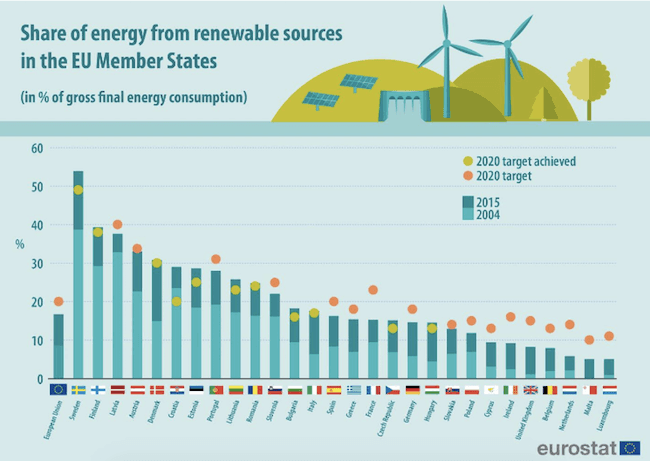
The clean-energy news from across the pond is looking good: Last week, the European Commission reported that renewables carved out an impressive 16.7 percent share of energy consumption among European Union members in 2015, practically twice the amount from 2004.
With Sweden, Finland and Latvia leading the way, the EU is collectively on track to meet its 2020 clean-energy target, and several member nations have already blown past that mark.
Over in the U.S., it's a different story . . . or is it?
EU has clean-energy goal in sight
The latest clean-energy news is derived from a report on 2015 energy patterns compiled by the EU agency Eurostat.
Among other things, Eurostat tracks gross final consumption of energy as a "headline" indicator for the Europe 2020 strategy, which calls for the EU to collectively source 20 percent of its energy from renewables by 2020. Within that target, each member has its own 2020 goal.
Aside from reaching a collective mark of almost 17 percent renewable energy, Eurostat reported that 11 member states have already reached their 2020 targets: Bulgaria, the Czech Republic, Denmark, Estonia, Croatia, Italy, Lithuania, Hungary, Romania, Finland and Sweden.
Austria and Slovakia are likely to meet the goal in time: Both are within 1 percent of their targets, Eurostat reported.
The EU's 2020 goal targets a 20 percent share for renewables in terms of gross final consumption -- which accounts for all energy use, including power generation and losses incurred during distribution. An additional agreement calls for 27 percent renewables by 2030.
By that measure, several countries have already run past the goalposts:
"Sweden led the way with more than half (53.9 percent) of its gross final consumption of energy coming from renewables in 2015, followed by Finland at 39.3 percent, Latvia at 37.6 percent and Austria at 33 percent," Eurostat reported.
While the EU still has a little way to go before it hits its target for gross final consumption, it already reached its 2020 target for final energy consumption: energy measured at the consumer end, including residential, industrial and other users.
Don't forget energy efficiency!
The skyrocketing growth of renewable energy generation of course plays a critical role in decarbonization, but the European Commission emphasizes that energy efficiency is also a vital factor.
The EU aims to improve energy efficiency goal by 20 percent by 2020 -- a goal it already met, which is reflected in the figures for final energy consumption.
The EU is not likely to stop there, considering the connection between efficiency improvements and economic activity:
"Energy efficiency is a key element of the clean energy transition," the European Commission said in a February press release."It unlocks the energy savings that boost growth in the EU's economy, investments and job creation. It brings cost savings for consumers, in addition to benefits in the form of the reduction of greenhouse gas emissions, improved air quality and increased security of supply, competitiveness, sustainability of the European economy and job creation."
Moving forward, one critical task facing the EU is upgrading its stock of buildings. In particular, heating and cooling present a major challenge. They account for half of energy consumption in the EU, and they still rely heavily on fossil fuels.
Meanwhile, much of the existing building stock -- about two-thirds -- was constructed before the advent of modern efficiency standards.
Based on the current rate of building renovation, the EU has some catching up to do: On average the EU renovation rate is around 1 percent per year. This means that renovating the entire EU building stock would take roughly 100 years.
The good news is that with the increased focus on energy efficiency, the rate of renovations is beginning to climb in several member states.
Clean Power Plan on autopilot
Meanwhile over in the U.S., clean-energy progress took a huge hit last fall when a majority of Electoral College votes went to Donald J. Trump for president.
As expected, the Trump administration is not particularly enamored with renewables (one exception is former Texas Gov. and wind energy fan Rick Perry, who now heads the Department of Energy).
Heading up the Environmental Protection Agency is noted climate change denier and former Oklahoma Attorney General Scott Pruitt. The EPA is the federal agency charged with administering the Clean Power Plan, which is on its way out, so there goes that.
It's not all about Pruitt, though. Even with a more science-respecting leader helming EPA, President Trump has made it clear that the Clean Power Plan is toast. The threat of deep cuts under the newly unveiled Trump budget isn't helping matters.
However, if and when the Clean Power Plan evaporates on paper, renewables will continue to make inroads against fossil fuels in the U.S.
Last fall, for example, the Environmental Defense Fund listed several major power companies that have already laid big plans to continue adding renewables as well as natural gas to replace coal. American Electric Power is representative:
"AEP is reducing emissions by replacing coal with renewables and natural gas," the Environmental Defense Fund reported. "AEP has already cut carbon dioxide emissions 39 percent from 2000 levels. The company plans to add 5,500 megawatts of wind, 3,000 megawatts of solar, and 3,000 megawatts of natural gas in the coming years."
That's nothing compared to MidAmerican Energy, which is aiming for 100 percent renewables:
"MidAmerican’s just approved $3.6 billion project to add 2,000 megawatts of wind — called the 'largest wind energy project in U.S. history' — will expand wind energy to become 85 percent of the company’s sales."
EDF also assembled some noteworthy examples of state progress on Clean Power Plan goals, much of which is attributed to switching from coal to natural gas.
Dozens of states and power companies sued to stop the Clean Power Plan, but many of these same stakeholders have already taken significant strides toward compliance and are not likely to change their plans.
Reuters took stock of the situation last fall and noted that "most" of the 27 states challenging the Clean Power Plan in court are "likely" to hit their targets:
"Already, Arkansas, North Carolina, Oklahoma and South Dakota appear to be meeting the CPP's early targets," wrote Nichola Groom and Valerie Volcovici of Reuters. "And changes in the power market, along with policies favoring clean generation, are propelling most of the rest toward timely compliance."
Power companies and states are not the only stakeholders that will continue to drive Clean Power Plan compliance. Cities and businesses have also emerged as important catalysts for climate action and eager adopters of renewables. That, too, is unlikely to change.
In another good sign, Republican legislators are beginning to join with Democrats in support of clean energy and climate action.
And finally, newly minted Secretary of State Rex Tillerson is fresh off a decades-long stint with ExxonMobil, where he spearheaded the company's push for natural gas as a replacement for coal.
Tillerson is in a perfect position to accelerates that effort under the Trump administration. Even without his help, coal will continue its downward slide in the U.S. despite the many times President Trump promised to bring back coal jobs.
Image (screenshot): via Eurostat

Tina writes frequently for TriplePundit and other websites, with a focus on military, government and corporate sustainability, clean tech research and emerging energy technologies. She is a former Deputy Director of Public Affairs of the New York City Department of Environmental Protection, and author of books and articles on recycling and other conservation themes.














